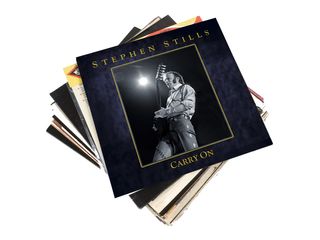
Stephen Stills talks classic tracks from his box set, Carry On
“When I heard my guitar playing on these songs, I thought, ‘OK, he’s still learning,'" says Stephen Stills. "'He's playing within his limitations. Maybe he'll get good by the time he’s 50.'"
Stills is talking about the 82 tracks that comprise Carry On, a sprawling four-CD career retrospective of the singer-songwriter and guitarist's work, both in the studio and on stage, as a solo artist and with an astonishing series of iconic bands: Buffalo Springfield, Manassas and, of course, Crosby, Stills & Nash (and sometimes Young).
The task of reviewing the material for the gargantuan set was not always an easy one for Stills, who admits that he'd much rather do anything else than listen to his own recordings. “I'm just not the kind of guy who sits around and stares at his own navel," he says. The guitarist underscores this fact with a surprising caveat he gave co-producers Graham Nash and Joel Bernstein: "They were planning on making it three CDs, but I said it had to be four. If we were going to do this, we were going to do it one time and have everything on there."
Nash and Bernstein worked for the better part of four years to track down, compile, remaster and, in some cases, remix the more than five hours of music that makes up Carry On. "I'm listed as a producer, but Graham and Joel did the lion's share of the work," says Stills. "Going through old boxes of tapes, trying to read credits and titles when the labels have been replaced – it’s a big job. I'm glad they did it because it would have taken me 10 years!"
Stills hadn't heard many of the recordings in decades – 25 of them are previously unreleased, the earliest of which, Travelin', dates back to 1962 when the guitarist was just 17 years old – and he says that, after he finally assessed the collection as a whole, he was surprised at the scope of the musical narrative that emerges from the collection. "It really does cover the arc of the career," he says. "There’s roots music, Travis picking, old blues, jazz. I don't think there are any stones unturned."
The material is arranged in a mostly chronological order, weaving a rich tapestry of American music, following Stills as he spreads the waters of folk-rock in the Buffalo Springfield; country-rock, psychedelia, hard rock and soaring contrapuntal vocal harmonies in CSN&Y; as well as soul-moving guitar poetry in Manassas. Magically, the set expands, revealing countless moments of epiphany and reverberant imagery, in the idiosyncratic visions and prescient imagination of Stills' solo albums and later-period recordings with his celebrated bandmates.
"It's quite a journey," the guitarist says. "I forgot how good a lot of it sounded. Quite a few times I'd say, 'Oh, my God. We had so much fun when we did that.' There were some real surprises. I couldn’t believe how good the arrangement of To A Flame [from Stills' 1970 eponymous debut solo album] was, the lush strings. Arif Mardin dragged that out of me, my classical training. Hearing it again just blew me away."
Carry On will be released on 26 March. You can pre-order the box set at this link. On the following pages, Stills offers his thoughts and reflections on 10 tracks from this must-have collection.
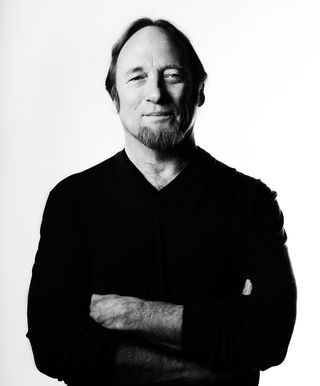
Travelin'
“I was a senior in high school in Costa Rica – that’s where we were living at the time because my dad was in the military. I was in bands, I was learning to play and getting into things like Travis picking. There wasn’t anything else to do but play the guitar. That's all there was to do, in fact! [Laughs]
“I didn’t have any intentions at this point, other than finishing high school so I could get the hell out of there and go to college in Gainesville, Florida. But this fellow said to me, ‘I’ve got to get you on record. I have to get you on tape.’ He had all of this recording equipment in his apartment. I went there, and it turned out to be the Voice Of America station. At least I think it was. Who knows what it really was? [Laughs]
“I hadn’t heard this recording in years. It was one of the first things done for the box set. Graham came back grinning like a Cheshire cat. ‘Wait till you hear this!’ he said. I listened to it and said, ‘Wow, that’s really great!'
"The song is so silly, and my voice sounds so strange, but I was just floored by the guitar playing. The fingerpicking I do on this emerged whole, and it’s kind of been the same my whole life. It’s my own little version of Travis picking."

Sit Down I Think I Love You
“This is one of the first things I wrote once I hit LA. A bunch of songs came flying out of me at the same time. I managed to wrangle a little two-track tape recorder, and that's what I used to put material down. I wrote the riff, the bass part, and I came up with the harmony. I was trying to join a band, but I wound up forming my own. [Laughs]
“I can’t recall the Mojo Men's cover of it. They were a great band, and I’m sure whatever they did is fine, but I don’t really notice that stuff. Covers of my own songs – I just don’t want to listen. It’s not a vanity thing, it’s a respect thing.”
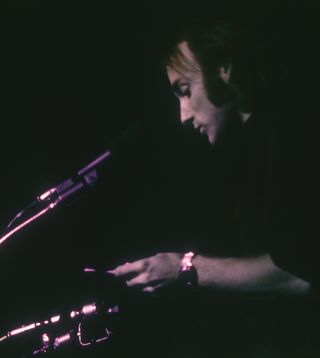
For What It's Worth
“Unfortunately, this song is all too pertinent today. When I wrote it, I was trying to figure out something to do about the kids in Vietnam, a shout-out to our folks. I thought it was terrible that I couldn’t talk to my friends who were over there; at the same time, I also didn’t like the way the teenagers were treating the soldiers, the ones who were just trying to keep their butts alive.
“The song started out with that germ of a thought. I had the guitar lick and the idea but nothing else. So I was riding in a car with somebody one day, and as we went the hill on Sunset Strip we came across a funeral for a bar called Pandora’s Box. The place was being torn down to make way for a shopping center, and they were having this funeral for it. Something like a thousand kids were there, and of course it spilled out into the street. By the time I got there, the mayor of Los Angeles had all of these cops lined up to deal with the situation.
“I saw this and said, ‘Turn the car around! Get me to a guitar!’ I went back to Topanga, picked up my guitar, and there it was. I was so transfixed by what I saw that the riff I had been playing with came out in the song. It took no time at all.
“It’s funny: The riff was very close to something Bob Moseley was doing in Moby Grape. Somebody said to me once, ‘Did you steal that?’ And I said, ‘I don’t know… Ask Bob!’” [Laughs]
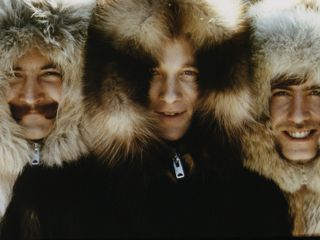
Forty-Nine Reasons
“There were other people involved, so the song changed from the demo that I had. The backwards guitar solo that I have on the original, the way that it twists and turns with the melody, it made me want to cry when I heard it again. It’s absolutely heart-stopping.
“As good as it was, that stuff just didn’t make the album version. It might have not made sense for a pop feel, I’m not sure. Playing backwards guitar is a very intuitive thing. It’s almost like reading Braille – you know where you are, sort of, but you have to remind yourself to invert the barre. Sometimes you do, and sometimes you don’t. You have to accept the accidents.
“I was using either an Ampeg or a Studer eight-track when I did that demo. Ahmet Ertegun had graciously allowed me to do whatever I wanted between Buffalo Springfield and whatever happened next. I would call into his office and get a PO number. It was like practice record making.”

Suite: Judy Blue Eyes
“It sort of glopped its way together out of pieces. It emerged out of the fractured state of my relationship [with singer Judy Collins]. There were just moments, and it kept changing all of the way through.
“It went from our meeting in California and then going to Colorado and Sag Harbor and New York. The contrast between the one on Just Roll Tape [a demo album released in 2007] and the one on CSN is pretty remarkable.
“I played a Fender Telecaster through a Leslie on the chorus. I like that sound when it’s slow. It’s pretty cool. When it’s fast, it sounds dorky. They had pretty much just invented that at the time, so I figured out how to do it. It’s a good recording.”
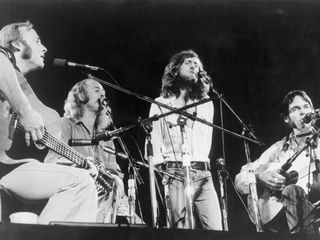
Carry On/Questions
“Questions is another one of those things that has one foot in one band and another foot in another. Having enjoyed a lot of success with the Suite, we decided to incorporate two different songs into one piece.
“It’s funny, because the two songs really don’t have anything to do with each other. They're apropos of nothing. But to people in the mindset of 1968, that’s the cool part. The ‘60s were nothing if not a miracle of free-association. In the studio, we started playing the two parts together, we practiced them that way, and we thought they sounded great. Who cares if they don’t sound anything alike? It works.
“During the ‘build-a-record’ part of it, the main thing was getting a groove with [drummer] Dallas [Taylor] – that and putting the acoustic guitar part down. We just went from there and built it.”
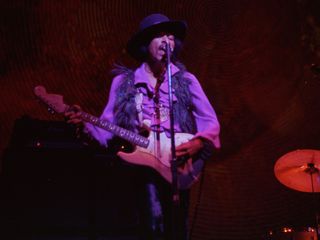
No-Name Jam
“It was done at the time of my first solo album. The original drums didn’t make it because they were on the edge of the tape. Joe Vitale did a really great drum part, and I did a bass part to make it clearer. When I got it back, I said, ‘This sounds like the original.’ On the original recording, I think it’s [drummer] Conrad [Isedor] and [bassist] ‘Fuzzy’ [Calvin Samuel].
“Jimi just walked into the studio, plugged in, and we practiced it twice. I sat down and tried to write some lyrics, but I never finished them. Jimi was nonplussed with the title, and so was I. In years since, it developed more of a cringe-factor. So I just decided to call it the ‘Jimi Jam,’ and there you go.
“It’s not like I was sitting on it for four decades, but I would have liked to have put more into it – put a real set of lyrics on it and so forth. It is what it is, and it’s certainly Jimi Hendrix – you can certainly tell that much.
“Jimi was a real gentleman and just the sweetest person in the world. He wanted me to play bass with him on tour after he came to loggerheads with Noel Redding. The jam is something of a bittersweet memory for me. I wish I had made it more of a song.”
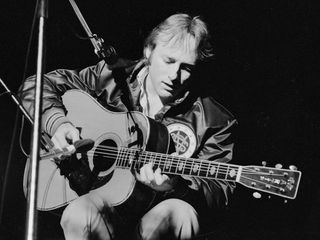
Love The One You're With
“You have the image of the rose in the fisted glove... Think of the War of the Four Roses. There’s an icon in England – I think it’s on a shield – of a chainmail fist with a rose in it. That's the image I had.
“The song means something altogether different to other people than what it means to me. I think it's a striking reflection of the times. I was in my safe haven in my country house in Britain, when every night was bachelor’s night out. We were looking for somebody, and relationships were kind of fluid. You have to remember when it was written and how old I was. If you think about it, you’ll realize exactly what the fuck it is! [Laughs] See, I never really was 'that guy.' Gene Simmons I’m not, by any stretch of the imagination.
“The steel drum was one of those blinding moments of inspiration in the studio. It came out so much cooler than anybody could have imagined. I should have started out the song with it – it's really a hook. I had done the song in England and was recording overdubs in Miami, and I must have heard a Trinidadian thing there. It was in my head. I discovered that lick and thought it was way cool. There’s not enough of it, as far as I’m concerned.”

Change Partners
“The song was done, and Jerry happened to be hanging around, so I said, ‘Hey, come into the studio and put pedal steel on it.’ I had no idea that pedal steels never stopped. Jerry started playing and just went through the whole thing. Pedal steels take up a lot of room, and you have to be really careful about how you use them.
“The opening lick that he did, now that’s one of those things you can sing in your head, which is why the Grateful Dead were the Grateful Dead [laughs]. It was the first thing out of his head, that wonderful little passage once the song starts.
“I wouldn’t let him do another take – that’s how much I liked the first lick. Actually, I think I told him he could do another take, but I was going to keep the first lick no matter what.”
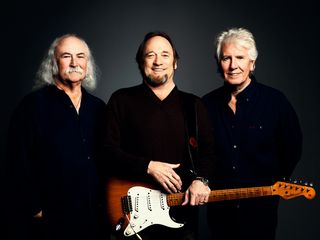
Girl From The North Country
“This is something I came up with. Here's a true story: I was in Northern Minnesota, riding in the bus, and I saw a sign that read, ‘Hibbing – 12 miles.’ And I thought, ‘Wow, Bob, so this is your neighborhood. It's flat and cold. I couldn’t imagine what it must have been like to grow up there.' It was the wintertime, and it looked like the opening shot of Fargo.
“That song came into my head. I think I played it when the album first came out, before I was anybody, back in my basket-passing days. So I resurrected it, started playing it, and I found a more comfortable key and figured out a great way to incorporate the guys.
“I’ll never forget Graham coming to me and saying, ‘So you want to do Girl From The North Country? Well, what are we supposed to do on it?’ And I said, ‘You’ll see.’ [Laughs] I let them stew, and then backstage at a soundcheck, I went, ‘So here’s how it is. Trust me, just sing this…’ And they thought it was marvelous. We had it within a day. Crosby came up with some strange little note phrase, just because he’s him. But it pretty much emerged from my imagination.”

Joe is a freelance journalist who has, over the past few decades, interviewed hundreds of guitarists for Guitar World, Guitar Player, MusicRadar and Classic Rock. He is also a former editor of Guitar World, contributing writer for Guitar Aficionado and VP of A&R for Island Records. He’s an enthusiastic guitarist, but he’s nowhere near the likes of the people he interviews. Surprisingly, his skills are more suited to the drums. If you need a drummer for your Beatles tribute band, look him up.

“Definitely one of the most unique pieces to come through our showroom”: It was left in a nightclub in '74, then “hidden in a closet for decades”, now Mike Bloomfield’s custom-painted 1966 Telecaster is up for sale

“There is still no power but we have survived”: Joe Bonamassa returns to Nerdville West, after LA wildfires threaten home and vintage gear collection

“Definitely one of the most unique pieces to come through our showroom”: It was left in a nightclub in '74, then “hidden in a closet for decades”, now Mike Bloomfield’s custom-painted 1966 Telecaster is up for sale

“There is still no power but we have survived”: Joe Bonamassa returns to Nerdville West, after LA wildfires threaten home and vintage gear collection
Most Popular







